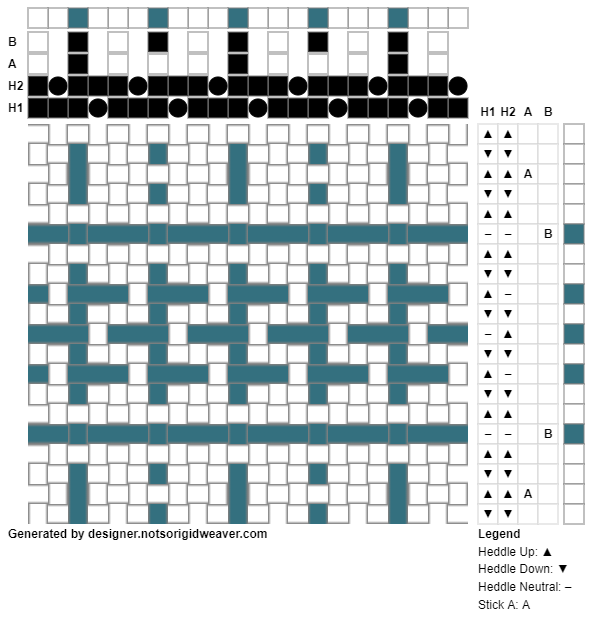Beginner Rigid Heddle Weaving Project Ideas
resourcesgetting startedproject ideasUpdated July 2022 with new link to Country Plaid Towels
These projects are all great ways to make useful items and experiment, when you’re first learning or learning a new technique. They can all be made with worsted or DK weight yarns with a 7.5 or 8 dent heddle.
Coasters #
Coasters are great for sampling colors, practicing color changes, and practicing hemstitch for the finish. They can be pretty much any thickness or material other than really thin or open weaves, and are great for odds and ends of yarn. These are perfect for some color and weave sampling - set up a warp with two colors in a pattern you’d like to try out, and do each coaster with a different weft pattern. These are also great for sampling any idea you’d like to turn into placemats.
Size at the heddle: About 4” (30 ends at 7.5 DPI)

In my example, the lighter color is a DK Cotton/Acrylic blend, and the blue is a mystery acrylic.
Hot Pads #
Basically a big coaster, ideally a little on the thicker side. In a thinner weave you could use it as an oversized coaster for going under a pitcher or teapot. Anything you can do with a coaster, and also particularly great for practicing thicker weaves like clasped weft or krokbragd. If you plan to use these for really hot things, e.g. straight out of the oven or off the stove, pay attention to materials and thickness; some synthetics can melt at high temperature and a thinner fabric may not provide enough protection.
Size at the heddle: 8-10” (60-75 ends at 7.5 DPI)

For example, I wove a 2 hot pads, roughly 8x8, to test out yarns for some clasped weft placemats, and try triple clasped weft for the first time. I put on a warp of about 40”. The yarns are Ashford 5/2 Cotton as the warp and mostly Sugar n' Cream worsted cotton as the weft.
Dishcloths #
Generally you’d make these out of unmercerized cotton. They can be a fun project to experiment with texture. These are typically going to need a hemmed finish; if you can, make the weaving a little thinner around the hem. In my example below that meant leaving 1.5” at the end of each cloth as plain weave, but it would have been better to weave that section using a thinner yarn.
Size at the heddle: Around 10” (I did 72 ends at 7.5 DPI)

Towels #
Most often done with a hemmed finish, but you can do a short hemstitched fringe finish if you’re not a sewer. Towels are also ideal for a color and weave or color gamp sampler with a set of yarns. If you are going with a hemmed finish, use some thinner yarn for an inch or so at the ends if you have it. Towels are often made of finer yarn, but you can make them with worsted cotton for a thick towel.

The Country Plaid Kitchen Towels by Darrin Hardman from rigidheddleweaver.com are a great towel for beginners without a sewing machine, with a size for 15” or 20” towels, and there's good instructions for making "split ply joins" to make the joins less bulky. Unfortunately the site is no longer active; I've uploaded the PDF here with permission from Darrin, and the tutorial videos mentioned in the PDF are on YouTube. I made them in two shades of blue.
Just a Sample #
While it’s nice to make useful items, sometimes it’s liberating to just experiment with different ideas without caring how the whole piece looks. It might be ugly as a whole piece, but have pieces of it that you love and want to reproduce in other projects! This is particularly useful if you have a stash of mystery yarns and want to learn if they’ll shrink the same. And sampling isn’t just for beginners - any time you have a project you aren’t sure about, or want to be precise about finished size, make a sample! It’s also a fun learning experience to just do a bit of sampling at the beginning or end of a warp. If I’ve got warp left over I go wild! The picture shows me playing with clasped weft at the end of the dishcloth warp. I learned that for clasped weft with worsted cotton I probably want a thinner warp - which I applied in the hot pad example above.

- Next: Hacks for Tension
- Previous: Weaving suppliers in Canada
Check out Not So Rigid Designer, the online weaving software for rigid heddle loom weavers!
